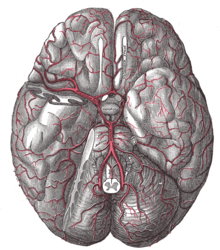Inferior posterior cerebellar artery
The inferior posterior cerebellar artery ( Latin for "lower rear cerebellar artery"; in clinical jargon also PICA , after English posterior inferior cerebellar artery ) is a pair of arterial blood vessels and one of the vessels supplying the brain . Normally it arises from the vertebral arteries ( arteriae vertebrales ) shortly before their confluence with the arteria basilaris as the branch of the largest caliber, circles the medulla oblongata (elongated medulla) towards the back towards the cerebellum and occurs between the X. and the XI. Cranial nerves through. In addition to the supply of most of the inferior cerebellar hemispheres and the sub-worm smaller side branches are also available for the perfusion of the posterior and lateral medulla oblongata responsible.
The course and size of the inferior posterior cerebellar artery are subject to marked variability. In about 10% of cases it emerges directly from the basilar artery .
An occlusion of the inferior posterior cerebellar artery leads to a cerebellar infarction and, if the proximal branches of the rami medullares mediales et laterales are closed , additional damage to the dorsolateral medulla oblongata can lead to a complex and variable symptom, the Wallenberg syndrome .
literature
- Theodor H. Schiebler, Walter Schmidt, Karl Zilles: Anatomie. Cytology, histology, history of development, macroscopic and microscopic human anatomy. 7th, corrected edition. Springer, Berlin et al. 1997, ISBN 3-540-61856-2 .
- Michael Schünke , Erik Schulte , Udo Schumacher : Prometheus. Anatomy Learning Atlas. Head, Neck and Neuroanatomy. 2nd, revised and expanded edition. Thieme, Stuttgart 2009, ISBN 978-3-13-139542-9 , p. 324 f.
